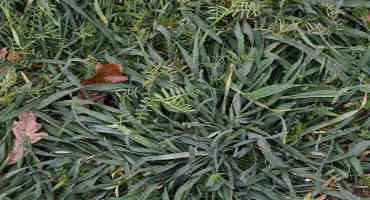By Michele Walfred
Winter is anything but a “slow” season in agriculture. Delaware’s winter months are as vital as spring’s planting, summer’s growth and autumn’s harvest. Winter is the time to cover up. For thousands of acres of Delaware farmland, the crucial seasonal practice adds a protective, verdant blanket into a farm’s crop rotation plan.
In the aftermath of the legendary Dust Bowl maladies of the early 20th century, planting cover crops was the takeaway lesson. Encouraging farmers to plant an intermediary crop in between production or “cash crops” became the mission of the U.S. Conservation Service, created to address the issue of soil erosion.
That mission continues with the National Resource Conservation Service (NRCS), a program within the U.S. Department of Agriculture. With offices in every state, the NRCS offers direct education and financial incentives for farmers. NRCS professionals works closely with Cooperative Extension professionals, certified crop advisers and related agriculture industry to share the cover crops’ benefits, which expand far beyond preventing soil erosion.
In 2019, researchers from the University of Delaware’s College of Agriculture and Natural Resources were awarded a grant from the NRCS to examine how cover crop mixes — the use of more than one seed type, and termination timing of the cover crop — might affect availability and uptake of nutrients needed by agronomic crops that follow in the spring. The study examines how cover crops affect Delaware’s main production crops — corn and soybeans.
Amy Shober, a professor in the Department of Plant and Soil Sciences and Extension specialist in nutrient management, and Jarrod Miller, assistant professor and Extension agronomy specialist, administer the grant. The grant provided funding for a research graduate student to participate in the project.
UD alumna Jamie Taraila, who graduated in 2018, learned about the project from Miller while serving as a communications intern at the Carvel Research Education Center in Georgetown, which serves as one of the locations for the study. Taraila formally applied as a graduate student in the Department of Plant and Soil Sciences and began initial research on the project in June. A second location is county-owned farmland in Middletown, known as Marl Pitt.
Keeping nutrients in the soil
“The two study locations are significantly different,” said Taraila. “The Carvel location in Georgetown is sandy, coastal soil and regularly irrigated. Our Middletown location is dryland and offers loamy, finely textured soil compared to Sussex. It was important to have Middletown as a part of the study to show farmers who don’t have irrigation what results may look like for them.”

Studying mixtures of different types of plants as a cover crop is an emerging trend.
“A lot of farmers plant a single type of cover crop,” said Miller. “But, now there is a big push toward mixing. A biomass builder, such as a tall cereal rye, pulls nitrogen out of the soil in the fall, and clovers add nitrogen in the spring when the cash crop needs the nutrient. We get both out of a cover crop mixture.”
“While use of cover crops has become more popular in Delaware in the past few years, growers still have questions about how to best manage cover crops to achieve the desired environmental benefits and realize profitable cash crop yields,” added Shober.
Traditional cover crops used in crop rotation are typically classified into cereal grains, such as sorghum, triticale, cereal rye, annual ryegrass; brassicas, such as canola or rapeseed, radishes and legumes such as crimson clover or hairy vetch. Cereal rye, hairy vetch and crimson clover grow quite tall and add biomass and organic matter for soil health.
“We are trying to hit a sweet spot when managing cover crops,” Shober said of the study. “We want to produce enough biomass to provide benefits like nitrogen scavenging, weed suppression or nitrogen fixation (in the case of the legumes). But, we also want to make sure that cover crop residues will not negatively impact planting, emergence or early season nitrogen uptake by the agronomic crop.”
With 2020 marking the second year of the study, Taraila and her faculty mentors frequently visit both locations where three different cover crop conditions are observed. Two mixes are planted — cereal rye with crown vetch and cereal rye with clover, and another planting of rye alone. Observations are also made on control plots without any cover crop.
Click here to see more...